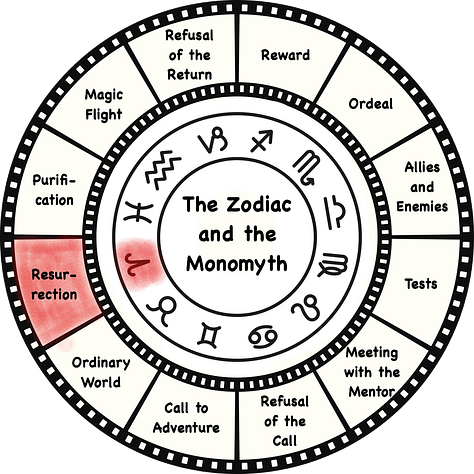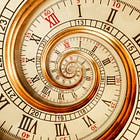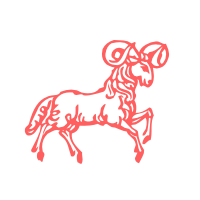Quest for the Elixir
This post is part of an ongoing series. If you’re new to it, you’ll want to read the introduction first (about 6 minutes):



Three Articles About a Chapter of the Universal Story
Each edition of Quest for the Elixir consists of three articles about one of the 12 chapters in the cyclical Universal Story.
The first article is an exploration of the chapter from the perspective of the Hero’s Journey in Joseph Campbell’s monomyth.
The second article is a view of the same chapter in terms of the Zodiac sign corresponding to it in the cycle.
The third article is about the meaning of the chapter as symbolized in a Major Arcana card of the tarot.
During the month of the Sun’s transit through Aries, we observe the Into the Light chapter in the Universal Story. In celebration, I offer the following three articles:
The Monomyth: Resurrection
“Only birth can conquer death — the birth , not of the old thing again, but of something new .”
― Joseph Campbell, The Hero With a Thousand Faces
Throughout the last phase of his story, our hero has been ‘dead’, or in a timeless state of consciousness, immersed in his dreams. Having been transformed by the progressively intense experiences of his story, he’s been cleansed of the details of his former hero life and prepared for a new one.
Now it’s time for him to wake up and head out of solitude and into a new life. From the perspective of timelessness, he’s had an opportunity to see that ultimately his life has been part of a story, and his place within it a temporary role. True, it was painful at times. But in a paradoxical way, his experience in the Illusion brought him closer to Truth as nothing else could have done. That he could be closer yet is reason to accept a part in another adventure. He’s developed a “new and improved” vision of his role in the story. If his current spiritual state has been ‘baked in’, and he’s already lost everything but his soul, what does he have to lose?
“I will participate in the game. It is a wonderful, wonderful opera – except that it hurts.”
― Joseph Campbell, The Power of Myth
This “Resurrection” phase in the monomyth is also known as “The Return with the Elixir”. Campbell reminds us that we come into the ordinary world not only to develop greater awareness and wisdom, but also with a destiny to help heal the world with the unique spiritual gift we bring with us.
In the Wizard of Oz example we’ve been following, Dorothy now wakes up in her bed back in Kansas. Although she retains some memory of her adventure in Oz, she can’t persuade any of her family or friends to believe it was real. They laugh and call it a “dream”. Was it a dream? It seemed to be real while she was in it, but from a Kansas perspective it was all a fantasy. Then again, aren’t Kansas and Oz, two different realities, ultimately both fantasies and real in their ways?
But what matters most now is the way Dorothy’s adventure in Oz transformed her. From now on, instead of taking the Ordinary World for granted, she’ll look on it through new, more enlightened and positive eyes, just glad to be alive.
Aries
The three Fire signs in the Zodiac reflect the powers of intuition that motivate our actions. Sagittarius encourages wisdom and spreads joy. Leo brings out and develops individual talents. Aries, transited by the Sun this month, motivates physical strength and kinetic action. In Aries we act to satisfy the basic needs of our body, or simply because there’s something we want to do.
Aries motivation is strong, focused, self-assertive and direct. What matters is the race toward a goal. There is eagerness and impatience to be on the move, and urgency to speed ahead of the crowd. A pioneering spirit and the courage to venture alone into unknown territory often gives Aries the distinction of being first to discover or accomplish something new. From an Aries perspective, other people are of no particular concern one way or another — unless they interfere with freedom of action, in which case Aries will act to get any annoying barriers out of the way as quickly as possible.
The Aries style is streamlined and minimal, as for a sport. Only what serves action and efficiency is desirable; nothing that might waste time or cause delay is acceptable.
In an astrological chart, houses represent the various ‘departments’ of life, and the places where they function. The natural house of Aries is the 1st house, located on the left side of the chart as shown in the wheel above. This house has a special distinction from the others. The sign on its cusp is known as the rising sign, and the planetary ruler of that sign is also the ruler of the chart. The cusp of the 1st house, known as the Ascendant, is the degree on the eastern horizon at the time of the birth (or event) represented by the chart. The Ascendant is one of the three most important features of the chart, the other two being the Sun and the Moon.
In a natal chart, the Ascendant and the 1st house (not the Sun sign) show the native’s original motivation for coming into the world. They define his general role in life, and can be thought of as a ‘label’ for the entire chart. By whatever sign is rising on the Ascendant and any occupying planets, the 1st house describes the native’s self-image, physical appearance, general attitude, and manner.
In the language of astrology, planets function as ‘nouns’ or ‘verbs’ that represent or express the various energies of life. Each sign reflects the qualities of the planet which rules it. Mars is the “classical” ruler of Aries. I am among those who consider Pluto to be Aries’ “modern” ruler.
Pluto is the counterbalance to Neptune; the two treat truth in opposite ways. Whereas Neptune is the apparently empty Blackness that invites projection and the formation of visions, Pluto is the White light symbolically comprising all living energies (all ‘colors’), thus able to penetrate through illusion and ‘recognize’ whatever ‘colors’ the visions may conceal.
In astrology, we experience Pluto’s effect as highly focused and powerfully cathartic. Unlike Uranus, Pluto doesn’t appear unexpectedly and shatter things into pieces to be rearranged. Instead, Pluto seems to lurk in the background for some time, slowly accumulating pressure and intensity until it ‘explodes’ like an erupting volcano and ‘gushes its contents to the surface’. The obsessive energy of Pluto is often expressed through repetition as the mind chips away at layers of something in order to experience it progressively more deeply and vividly. If Pluto removes something, it doesn’t leave any pieces. Pluto’s activation in a chart can indicate the effect of a radical transformation, as something drops out of sight or ceases to exist, while something else may seem to appear out of nowhere.
Plutonian objects include instruments for viewing hidden things (x-ray, CT scan, MRI, etc.) and exploding weapons like bombs. Plutonian people are those who investigate hidden factors, such as x-ray technicians, detectives, psychologists, and some mystics.
Surely the revelation of truth is always a good thing, we might think. How could such an energy be bad? Essential truths can be hidden beneath many layers of illusion, which Pluto reveals in stages, like a peeling away of onion skins that is never quite complete. Not everyone has penetrated the layers very deeply, and no one can penetrate them all. Most of us simply perceive truth as best we can and live by what we understand it to be. Deep Plutonian insights do confer unusual powers of awareness, but that power belongs to the Source of Life and not to anyone’s ego. Unfortunately, there are those who overestimate their understanding, recognize no Higher Power, and vainly attribute Pluto’s energy to their own egos. These are the megalomaniacs who believe they are superior and entitled to dominate everyone else. That’s hubris, which is self-destructive and has a way of backfiring hugely.
Mars was considered to be the ruler of Aries long before the discovery of Pluto. Mars is the primitive ‘fuel’ that powers physical motion: the circulation of blood, the movement of living creatures, the “rat race” for necessities, desire and the “pursuit of happiness” — the vital flow of the ‘river’ of life. Where Mars is, there is fast action, struggle, and/or some inevitable emotional or physical pain, especially that of bloody injuries and fevers. The energy of Mars is urgent and uncomfortable, but we couldn’t live on earth without it.
Mars used to be thought of as a “malefic”, or bad planet. Is Mars essentially evil? No, but it’s primitive, a crude survival instinct. Coming from the awareness of a wild animal or newborn infant, Mars is asocial and concerned only with physical drives and personal desires. That’s not bad in itself, but in humans, at least, it needs to be tempered by social awareness that normally develops through interaction with others. When for whatever reason it isn’t, Mars can turn easily from survival needs to wanton aggression, inciting conflict, vicious competition, exploitation, and violence. That’s negative Mars, and it needs to be prevented from doing harm.
We make the best use of our natural positive Martial energy when we use it constructively. It’s not as though we don’t have enough inevitable trouble to cope with, enough need of productivity, or enough regrettable mistakes that require some kind of reconstruction. Otherwise, we need only take care to avoid harming others on our own “pursuit of happiness”.
We have a choice as to how we handle our encounters with negative Mars. We can participate in an endless exchange of blame and retaliation, or we can fortify our territory and strictly limit our action to vigilant defense. Of course, we have to confirm our choices with actual deeds.
Martial people are healthy, strong, physically active and often competitive: athletes, racers, fighters, and physical laborers. Martial objects include cutting tools, machinery, basic weapons and heavy-duty power tools designed for fast, efficient (and usually noisy) action.
The Tower
At the top of a steep mountain crag stands a tall stone tower that has windows but no visible door. The people who had been inside the tower must have struggled to the top of the mountain and stopped there with no further place to go. It may have been a dark and lonely prison, but we don’t see them in there now. In this violent, earthshaking scene, a huge bolt of lightning has struck off the top of the tower and illuminated the inside with blinding white light. As fire destroys the rooms they had occupied, two people who have been thrown out of the tower and out into the world are falling head first toward the earth.
The description of the “Resurrection” phase is sketchy in the monomyth, which, after all, focuses mainly on the hero’s action in the story. We are told that the hero returns to the Ordinary World with a transformed perspective and an elixir, but we hear little or nothing about that transition.
Astrology underscores the importance of (re)birth by its emphasis of the Ascendant and the 1st house, the natural house of Fiery Aries, where the very will to live a life is reflected. This initial expression of will is distinct from the world into which the new life is emerging, which belongs to Earthy Taurus and the 2nd house. Tarot and the monomyth don’t normally make such a clear distinction between the two.
In tarot, the idea of resurrection is often associated with the “Judgment” card that depicts dead people rising into a fresh new world. As an astrologer, I agree that “Judgment” shows a new world, and I see no reasons why traditional interpretations of it shouldn’t apply. But “The Tower” better expresses the passion and struggle required to come into that new world, which in my view is the real act of resurrection. It suggests meanings around the dramatic experience of labor and transition from the inner world to the outer one, which surely merits a card of its own.
Let’s consider the soul who has been languishing in darkness and isolation as the Hanged Man. What can you do when your former life has been washed away, and even the visions that remain to you have been consolidated into a single dream that you would love to live out as an experience in a new body if only you could? Your dream grows more vivid and true for you as it recurs over, and over, and over again. All you want is to live out the deepest truth you know, but you can do nothing — until a Higher Power ‘turns on the light’ and forces your struggle out of confinement and into the new world you’ve been longing to experience. Instant? Painless? Ask any woman who’s been through childbirth what it’s like, and what changes it brings.
So, in my view, “The Tower” expresses the stressful and courageous transition back into the flow of the ‘river’ of life after a deep purification. Whether the birth experience be literal or metaphorical, it’s an emergence into a brand new life.
How we “wake up” in the world exactly where and when we need to be is a mystery, but apparently that’s what we do, with both meaning and purpose.
“Since you came to birth in this world at this time, in this place, and with this particular destiny, it was this indeed that you wanted and required for your own ultimate illumination. That was a great big wonderful thing that you thereupon brought to pass: not the "you" of course, that you now suppose yourself to be, but the "you" that was already there before you were born. You are not now to lose your nerve! Go on through with it and play your own game all the way!”
― Joseph Campbell, Myths to Live By
In divination, I read the Tower as a release from a frustrating restriction.
If it’s reversed, I read it as frustration in a restricting situation. Someone would like to be free, but cannot be as yet.










